Bitcoin staking is a relatively new opportunity that allows BTC holders to get rewards without selling their assets. Unlike traditional Proof-of-Work mining, staking lets users participate in securing a blockchain network by delegating their tokens to trusted validators. This process supports decentralization while providing an additional way to engage with the Bitcoin ecosystem.
In this guide, we’ll explore how BTC staking works within the CoreDAO ecosystem, what makes this model unique, and how to stake your Bitcoin step by step using the Everstake validator.
What Is BTC Staking and Why It Matters
Traditionally, Bitcoin operates on the Proof-of-Work (PoW) consensus mechanism, where miners secure the network by solving complex mathematical problems. However, emerging cross-chain technologies now make it possible to stake BTC, to lock your Bitcoin temporarily to support network security and get rewards, without transferring ownership of your assets.
BTC staking bridges the gap between Bitcoin’s strong security foundation and the efficiency of Proof-of-Stake (PoS) systems. It offers several key advantages:
- You continue to fully own and control your BTC.
- You support network decentralization and security.
- You get staking rewards for your participation.
- You expand the utility of Bitcoin beyond storage and transfers.
In essence, BTC staking allows Bitcoin holders to actively contribute to decentralized ecosystems like CoreDAO, while keeping their assets safe in their own wallets.
About CoreDAO
CoreDAO is a decentralized blockchain that combines the strengths of Bitcoin and Ethereum to create a secure, scalable, and efficient ecosystem. At the heart of its design lies the Satoshi Plus consensus, which merges Bitcoin’s Proof-of-Work security with the Delegated Proof-of-Stake (DPoS) efficiency.
This hybrid model allows Bitcoin holders to participate in staking without giving up custody of their assets. By connecting Bitcoin to CoreDAO, users can delegate their BTC to validators and contribute to network governance and stability.
Another key feature of CoreDAO is Dual Staking, which enables users to stake both CORE and BTC simultaneously. This approach not only strengthens network security but also broadens participation for users who want to engage with the ecosystem on multiple levels.
With its cross-chain design, CoreDAO bridges Bitcoin’s robust foundation and the flexibility of modern staking, making BTC staking accessible, transparent, and secure.
How to Stake BTC with CoreDAO via Everstake
Follow these steps to stake your Bitcoin securely using CoreDAO’s official staking interface and Everstake’s validator.
Step 1. Connect Your Core Wallet
- Visit the Everstake validator page on CoreDAO.
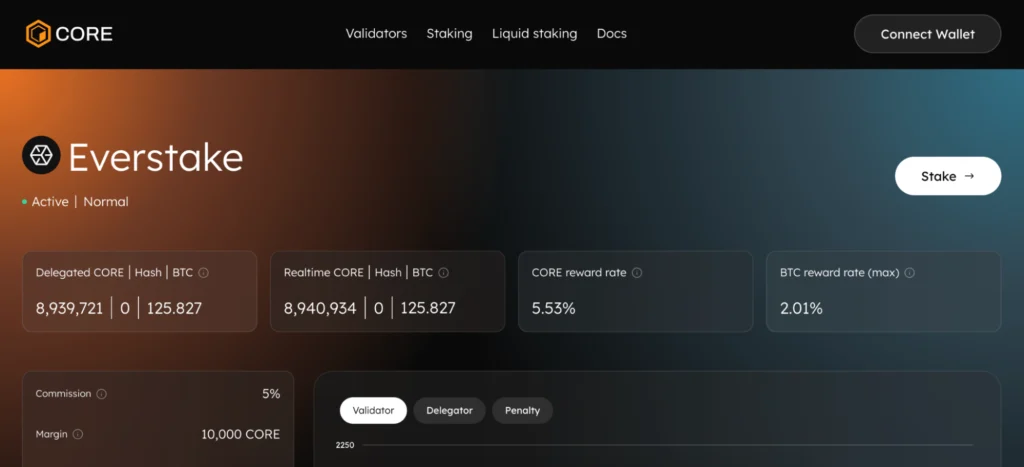
- In the top right corner, click Connect Wallet.
- From the list of supported options, select your preferred Core wallet.
For this walkthrough, we’ll use OKX Wallet.
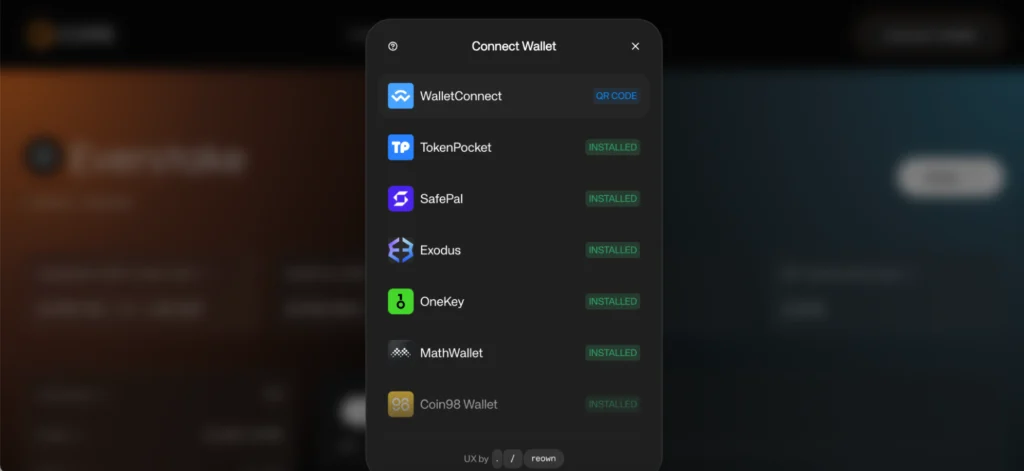
- Confirm the connection request in your wallet to authorize access to the staking website.
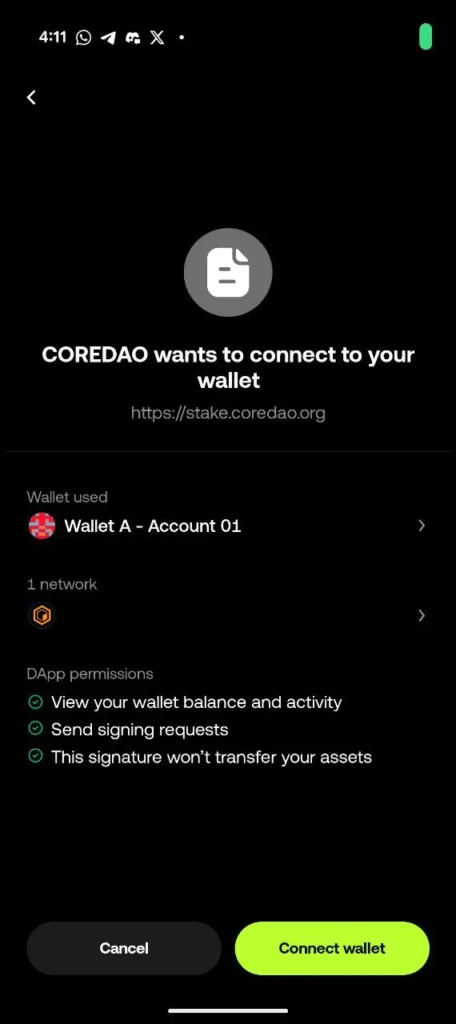
Step 2. Start the Staking Process
- Click the Stake button.
- Choose BTC as the asset you want to delegate.
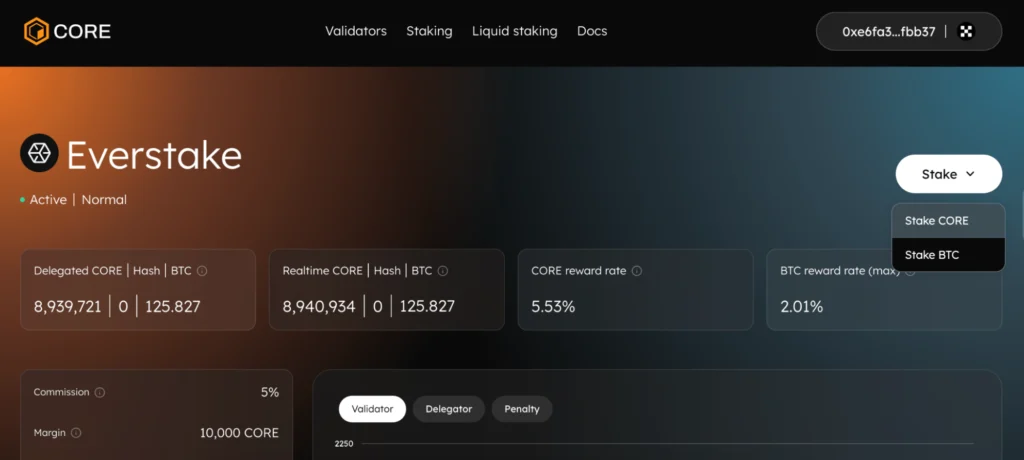
- To connect your Bitcoin wallet, select it from the supported options — for example, Unisat Wallet.

- Approve the connection request in your Bitcoin wallet.
Step 3. Set Your Staking Parameters
Once your wallets are connected, specify the key parameters for your staking transaction:
- Amount of BTC to delegate
The minimum staking amount is 0.01 BTC (when using the official CoreDAO UI).
In this example, we’ll delegate 0.05 BTC, which meets the minimum requirement.
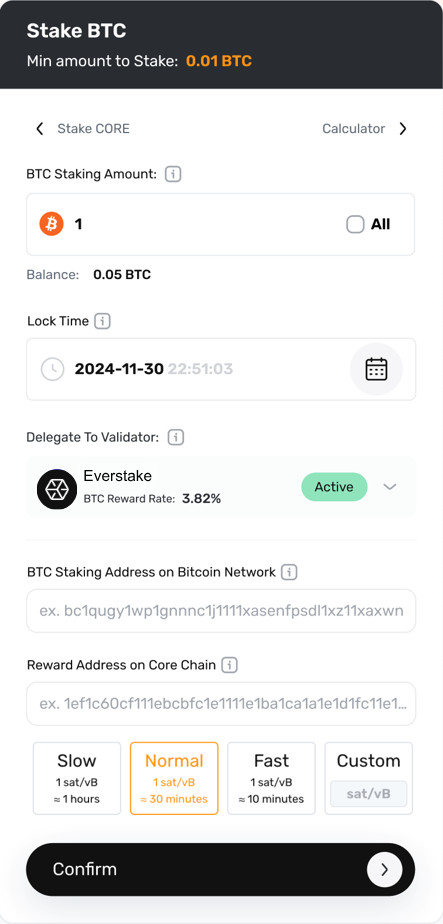
- Lock time
Determines when your staked BTC will become available for withdrawal or redelegation.
Click inside the lock time box to manually input a date, or use the calendar icon to select one.
By default, the lock time is set one month ahead.
- Transaction priority
Choose the desired network speed for your transaction based on fee preferences.
Step 4. Verify the OP_Return Output
Before signing the transaction in your wallet, check that it includes an OP_Return output.
This output stores your redeem_script, which is essential for reclaiming your staked BTC later.
There may be two or three outputs in total, but at least one should always be OP_Return.
If the transaction doesn’t include this output, abort the transaction to avoid potential loss of funds.
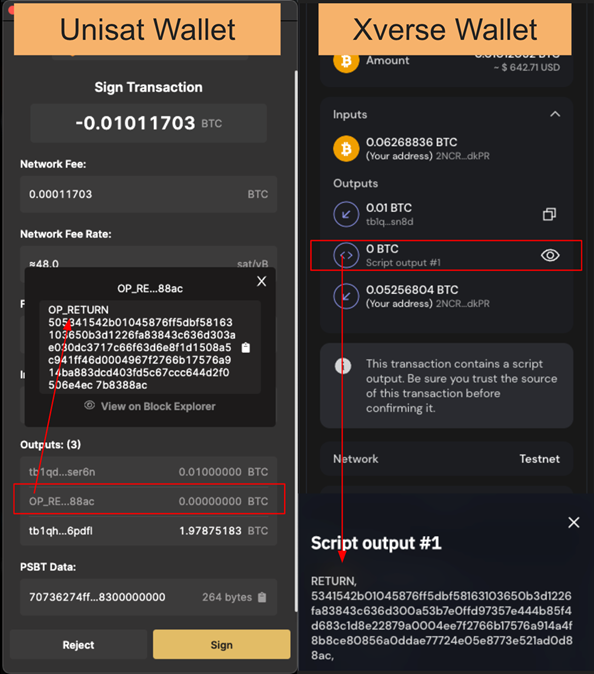
Step 5. Confirm and Submit the Transaction
Once verified, confirm the transaction in your wallet.
You’ll see a Transaction Submitted notification once your delegation has been successfully sent to the network.
Step 6. Track Your Delegation
After submission, you can monitor your staking status in the My Stakes section or directly on the Everstake validator page.
Here, you’ll be able to review your active delegations, lock times, and accumulated rewards.
Conclusion
Staking BTC through CoreDAO opens up a new chapter for Bitcoin holders who want to participate in decentralized networks without compromising security or ownership. By combining Bitcoin’s robust Proof-of-Work foundation with the efficiency of CoreDAO’s Satoshi Plus consensus, users can engage in staking safely and transparently.
Through trusted validators like Everstake, the process is straightforward: connect your wallets, set your parameters, confirm the transaction, and track your rewards. BTC staking with CoreDAO not only strengthens the network but also allows you to make your Bitcoin work for you in a secure, non-custodial way.
Stake with Everstake | Follow us on X | Connect with us on Discord
***
Everstake, Inc. or any of its affiliates is a software platform that provides infrastructure tools and resources for users but does not offer investment advice or investment opportunities, manage funds, facilitate collective investment schemes, provide financial services or take custody of, or otherwise hold or manage, customer assets. Everstake, Inc. or any of its affiliates does not conduct any independent diligence on or substantive review of any blockchain asset, digital currency, cryptocurrency or associated funds. Everstake, Inc. or any of its affiliates’s provision of technology services allowing a user to stake digital assets is not an endorsement or a recommendation of any digital assets by it. Users are fully and solely responsible for evaluating whether to stake digital assets.
